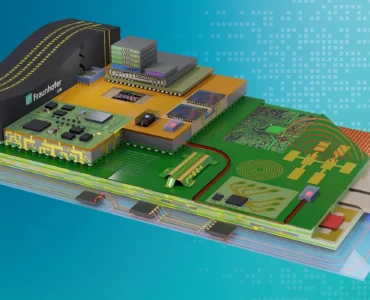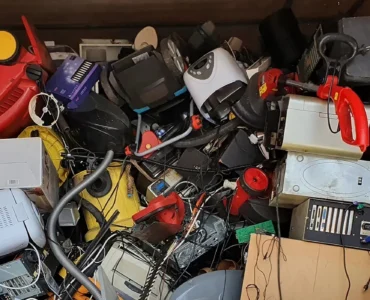The Outer Space Treaty of 1967 stipulates that every nation enjoys free access to space. For the last 20 years, more and more nations have been launching commercial projects in space. Private spaceflight companies are planning to use micro and nanosatellites to achieve seamless global internet coverage. End of 2021, nearly 4,900 satellites were orbiting the Earth*, and their number is currently increasing at high growth rates.
RealIZM spoke with Erik Jung, Senior Researcher in the Business Unit Development at Fraunhofer IZM in Berlin. How did the satellite boom come about? How are electronics made fit for such extreme environments? What challenges do the new space players have to face? What are the forecasts for future developments in semiconductor technology?
In your opinion, what are the groundbreaking developments in the field of electronics that are already being used in space?
Erik Jung: Microelectronics has made a decisive contribution to creating new possibilities in the field of communications that would have been unimaginable 20 years ago. Today, communications satellites with ever higher bandwidths enable us to transmit data and communicate extremely quickly and at very high frequency ranges. In the past, satellite communications meant TV broadcasts. Today, it’s internet streaming services like Netflix and their ilk, but also real time stock market exchange!
In the past, the direct point-to-point link from communication satellites to the receiving station still had to be tracked mechanically. Today, the switch to electronic tracking allows for the production of more robust and lightweight systems.
In addition, more powerful sensor technology is available for Earth observation. With this, the Earth’s surface can be measured with much higher precision and for a wide range of applications as far as spectral information is concerned. Radar enables us to determine the Earth’s surface topography with centimeter precision. For the first time, we have a complete bird’s eye view of what is happening on our planet. For example, we can visualize and document large-scale flooding, forest fires, or drought events. This offers numerous advantages and new fields of application for geo-surveying, agriculture, weather observation, and also for disaster forecasting and monitoring.
Bringing new technologies to market is very cost-intensive. Who is behind the development of space electronics, and how are they doing it? Is there investment in the development of new space technologies because there is simply demand for it, or is it because of new important research findings?
Erik Jung: In the days when satellite technology was still the preserve of state-affiliated players, there were usually political and scientific benchmarks that research and development was based on.
As communications and satellite technologies continued to evolve, new commercial applications emerged that powered new developments. For example, satellites are used for communication between exchanges to transmit information easily and very quickly. In this case, milliseconds count that would be lost in a wired transmission.
Availability of high-performance electronic systems through ubiquitous miniaturization is currently accelerating market development and designs: satellites are becoming smaller, lighter, and more highly integrated. The increasing importance of microsatellites and their affordability is bringing in more and more new market players, such as universities and commercial actors. With each rocket launch, several satellites can be put into space in one go. And this opportunity is met with great demand.
Over the last 20 years, a paradigm shift has taken place. You had the original approach: There is an idea, then financing is sought, and a lot of money is invested in the project including component development. The current approach is: Technologies, so-called COTS components, are used that are already available. Theoretically, anyone can nowadays buy a satellite slot or, as with a container ship, a payload share in a satellite. That would have been unthinkable in the past.
So, in summary, the market for space electronics is in a state of flux. Whereas previously there were a few active state players, today the market is more diverse, more colorful, and also more commercially minded…
Erik Jung: However, against the backdrop of today’s political environment, one thing must not be forgotten: There are satellite concepts that are used for defense and security. That remains the territory of state actors. All other areas of application are increasingly determined by commercial actors.
Space is a very extreme environment. Temperature differences range from near absolute zero up to extreme plus temperatures. How do electronics become fit for use in orbit?
Erik Jung: When a satellite is in orbit, it has a side facing the sun and a side facing away from the sun over the course of the day. On the inside, the sun-facing side can get as hot as hundreds of degrees C, while the other side has subzero temperatures near 0K – even more extreme for missions near the sun. Thermally conductive components are used to try and create a balance between these thermal extremes. The joining technology suffers from temperature cycles. One promising approach is monolithic integration. Anything that can be done to bring semiconductors and components closer together helps with thermal balancing.
One aspect not to be neglected is the impact of cosmic rays on state-of-the-art circuits as well. In today’s systems, memory errors (so called soft errors) occur very frequently. These cause a bit to be flipped and, as a result, a different operating state of the semiconductor may be initiated. If, for example, a modern car drives into high mountains, you will see more and more error messages coming in from the CPU because a bit flip happens. On earth, this can be handled well – in orbit or in free space, this is much more critical.
The more integrated the semiconductor components are, the fewer possibilities there are to compensate for a bit error (bit flip). In semiconductors with structure sizes of maybe 5 nanometers, the cached charge is only a few electrons. It can therefore become critical very quickly. These challenges can be countered with some circuit redundancy.
The shielding option works primarily against particles like micrometeorites or proton radiation. Against the omnipresent cosmic gamma radiation, unfortunately, there is as yet no option other than using thick material. However, this conflicts with the approach of sending systems into orbit that are as lightweight as possible.
The extreme environmental conditions of space – especially cosmic radiation – will cause us increasing problems. Further development of Earth-based electronics is currently focusing on scaling CMOS technologies further down to 2 nanometers or, prospectively, down to 20 Ångström. It would be a shame if satellites were not fit enough for orbital use despite low-cost production. To my knowledge, there is only one research facility in Germany that can test radiation challenges on electronic systems. I would like to see us succeed in transferring even more know-how from past projects to current and future research projects.
To what extent does the issue of sustainable and the ecologically sustainable use of resources play a role in the development of space electronics?
Erik Jung: The technical challenges we currently face in making electronics fit for orbit and keeping them operational there, admittedly, have other priorities. As long as satellites are still equipped with plutonium batteries, the issue of new green technologies plays only a minor role. However, I am sure that developments in the sustainable use of resources in conventional electronics will also have positive effects on space electronics in the long term.
In what way is Fraunhofer IZM involved in the development of technologies specifically for use in space?
Erik Jung: Research institutes always interact with numerous partners as a matter of principle. By cooperating and sharing knowledge, we add important pieces to the bigger picture. At Fraunhofer IZM, we have the expertise to examine questions about possible applications of assembly and joining technologies in extreme environments. As a result, we can make recommendations as to which approach might be most promising for the project in question.
The topic of microintegration plays a key role for uses in space. The demand for significant weight reduction in electronics and improved reliability is very high. Fraunhofer IZM is one of the pioneers in the field of integrating electronic modules into printed circuit boards. Our mission is to make electronics increasingly robust, smaller, lighter, and equipped with greater functional integration. From the initial design phase to implementation and reliability evaluation, our research groups make an important contribution to the modularization of space electronics.
One technology that has already found its way into space electronics is phased array antennas. In the past, control electronics were housed in a separate control block. Now, control elements are integrated into antenna panels. This approach was largely developed by researchers at IZM and is being continuously improved. It is a very pleasant experience to see that we are often involved very early on in the concept phase of university projects for small satellites. For example, using the outer shell of satellites as an antenna is a conceptual approach that we are currently discussing.
What challenges will space electronics players face in the next ten years?
Erik Jung: In the next decade, the cost factor will largely determine the trends and developments in space technologies. In the past, components were manufactured and intensively tested specifically for use in space. As a result, these were sometimes up to 100 times more expensive than comparable commercial components. But by now, components readily available on the market are increasingly being used redundantly. For example, two to four identical systems are used simultaneously. If one of the systems fails, the others take over.
I said at the beginning that several satellites can be launched into space at the same time with a single rocket launch. There is great demand for this. The more satellites there are in orbit, the greater the danger of a possible collision and, unfortunately, the “littering of space” also increases.
The lifetime of satellite systems is getting shorter and each new generation more powerful. When a satellite no longer fulfills its need and its operational lifetime has ended, it is written off. Ideally, it descends in its orbital position over its lifetime until, after its expected lifetime, it is slowed down by the atmosphere so much that it crashes and burns up. However, this is not always the case. Therefore, there are strategies to bring commercial satellites down in a targeted manner.
It is conceivable, for example, to use a supply of propellant intended for this purpose to guide the satellite specifically into a crash trajectory. It is also possible, in the case of microsatellites without sufficient fuel, to deploy sails. These use the solar wind and radiation pressure to slow down the satellite so that its orbit becomes smaller and the satellite finally crashes. In addition, concepts are also being discussed for satellites to actively remove themselves or for them to be collected again in orbit by so-called garbage collectors.
What technological developments do you think will determine the use of electronics in space over the next 50 years?
Erik Jung: Any forecast for microelectronics spanning 50 years is very difficult. It is not without reason that the International Roadmap for Devices and Systems (IRDS) only gives a forecast of future developments in semiconductor technology for the next 15 years.
In microelectronics, there are numerous current developments that will also be used in space with a 10-year offset. In antenna systems, it is now possible to realize conformal, electronically controlled antennas. However, they have not yet been tested for use in space. The approach is to control the optimal alignment for communication electronically, independent of the satellite’s position. A positive side effect would be that no fuel would be required for a change in its position.
We are already seeing significant progress in energy generation. There are now solar cells that can absorb a very broad spectrum of sunlight – far beyond what silicon is actually capable of. The first of these cells, before they are used on Earth, are already being used in space. There, the demand for such power sources is much more urgent.
An important milestone will be fully integrated systems that combine photonic-optical and microelectronic systems into a monolithic block. Compared to the elements that are still very complex to assemble today, a monolithic or heterogenous manufacturing process would offer several advantages. It would further improve reliability, reduce costs, and at the same time increase functionality per available volume and per available area.
Approaches from the field of neuromorphic computing also offer promising future scenarios for microelectronics. In the future, we will see systems that no longer have a predefined function. In order to fulfill its tasks, the semiconductor will more or less configure itself. Like a biological model, systems are sent on a mission with a certain basic set of prerequisites. When they encounter certain external influences, they can actively adapt to them, e.g. move memory areas or automatically reconfigure connections between memory areas.
We are still at a very early stage of research into semiconductor concepts that are not bound to the Von Neumann architecture, in which computing unit and memory are still strictly separated. Exciting times and developments are ahead of us here, which are likely to be marketable in 10 years at the earliest.
Certainly, in 50 years, we will be a few steps closer to the dream of the “artificial sun” – nuclear fusion. Just recently, there was news that a Chinese research group succeeded in maintaining stable plasma operation for 1,056 seconds at a temperature of nearly 70 million degrees Celsius. Whether a fusion reactor, which today has the size of a gymnasium, will in 50 years be brought down to the size of an orange and be ready to power spacecraft, only time will tell. I would like to see it, but I also have my reservations.
*Source: Statista (Stand: 31.12.2021)
This interview was conducted and edited by Katja Arnhold.
Picture: Volker Mai, Fraunhofer IZM





Add comment